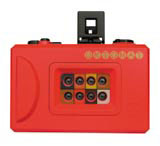Snap happy
Quentin Newark is smitten with the lo-tech charm of the latest Lomo camera, which puts fun and spontaneity back into photography

The Lomo Oktomat launches this week. It announces itself as: ‘eight lenses, eight levels, eight little pictures on one print in two seconds’. The effect is somewhere in between a Polaroid and eight frames of a video.
In case you hadn’t noticed, the Lomo isn’t so much a make of camera as a social phenomenon. There is a Lomographic Society you can join, worldwide exhibitions, books, competitions, a massive website, and constant launches of new variations on the basic camera; four lenses, six, nine, and now eight with a time delay. The cameras are poppy, young, colourful, plastic, cheap and made in China. You don’t take photographs, but lomographs. (An echo of Man Ray, who called his pictures rayographs.)
The Lomo was originally Russian, a copy of a simple Japanese camera, produced in 1982 by the Lomo Russian Arms and Optical factory. It was the last gasp of the amazing Russian military engineers, who were adept at designing something simple and robust that could be manufactured by the million, (like the T32 tank and the Kalashnikov assault rifle).
The first camera was compact and practically indestructible, with a very high quality lens capable of working in very low light conditions. After the collapse of Communism, Lomos began to appear in Germany and Austria. Their simplicity contrasted favourably with ridiculously sophisticated Japanese cameras, which were covered in lasers, flashing lights and computer displays, and the cult of Lomography began.
None of this is really new. The word ‘snapshot’ was originally taken from hunting; hunters would creep through the forest, gun cocked, and snap off a shot at any animal movement. The ‘ten rules of Lomography’, which boil down to ‘just shoot’, are a mirror of the techniques of all the great photographers, who used snapshots as the basis of their style, from Henri Cartier-Bresson to Wegee.
A photographer I know, looking at Elliott Erwitt’s contact sheets, was surprised that almost all of them were out of focus. Erwitt stalks the streets, beaches and museums of the world, eyes peeled, camera set to one aperture and one focus. What matters to him is capturing what he is seeing. If he starts worrying about depth-of-field, the moment is over.
Is the Lomo technically so innovative? It has many precedents, from the beautiful cartridge-loaded Instamatic 126 my mum used on our holidays, all the way back to the Kodak Box Brownie with its Lomo-like slogan, ‘You push the button, we’ll do the rest’. The multiple images on a single frame of film aren’t particularly novel, either. The dinky Olympus Pen of the 1950s put two images on to one 35mm frame.
But so what? What this new camera does, like the sudden appearance of cameras on our mobiles, is make photography unintimidating, fun, and democratic. It allows us to ignore whatever ‘good’ photography might be thought to be. The Oktomat, priced at £26.99, with its weird time lag, gives us the opportunity to ‘just shoot’, and create a dynamic, unexpected aesthetic record of our experience.
It make pictures, and the aesthetic effects of pictures, part of everyday life. You trap and make a tiny piece of art of something that would otherwise melt away.
-
Post a comment




